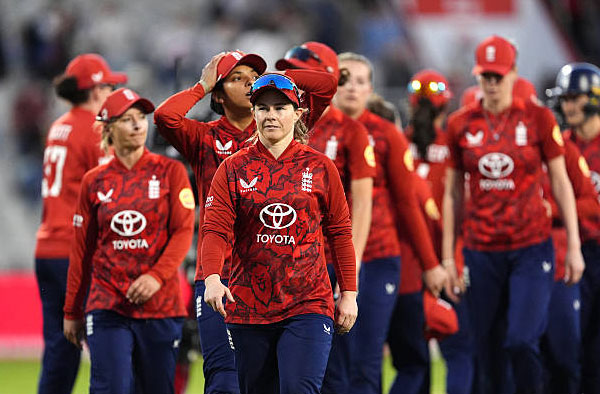July 9, 2025, will be etched in the history books for the Indian women’s cricket team, as they defeated England in a T20I series for the first time. The historic win came on English soil, making the achievement even more special. With the ICC Women’s T20 World Cup set to be held in England next year, this victory serves as a timely confidence boost.

The visitors have been clinical in all their wins, playing positive and disciplined cricket throughout the series. All three departments have performed strongly for Team India, which is reflected in the series scoreline.
On the other hand, England looked to be in good form under the new captain-coach duo of Nat Sciver-Brunt and Charlotte Edwards, showing early promise heading into the series. However, the England Women’s team faced several challenges during the five-match T20I series against India in 2025 and now find themselves trailing 3-1 with one match to go.
Here’s an analysis of five key factors that may have contributed to England’s struggles in the ongoing T20I series against India:
1. Opening Batters’ Woes
Heading into the series, openers Sophia Dunkley and Danni Wyatt-Hodge showed good form in the preceding West Series. However, both batters struggled against the Indian bowling attack. Aside from their 137-run partnership in the third T20I, they registered a string of low scores, managing only 9, 2, and 21 runs in the other matches. Individually, the openers have also struggled to consistently score runs. Sophia Dunkley, aside from her impressive 75 in the third T20I, has managed only 105 runs across the four matches. Meanwhile, her experienced partner, veteran Danni Wyatt-Hodge, has been a concern with her form, posting scores of 0, 1, 66, and 5 in the series. With one match remaining and the inclusion of Maia Bouchier, England may look to try a new opening combination in the final T20I.
2. Fielding Errors and Dropped Catches
England’s fielding was below par, especially in the first T20I at Trent Bridge. Dropped catches and sloppy fielding allowed India to post a formidable 210/5, highlighted by Smriti Mandhana’s maiden T20I century (112 off 62). England all-rounder Alice Capsey also dropped crucial catches of Harleen Deol, who went on to score a quickfire 43, and Amanjot Kaur. These errors put England under early pressure and hampered their ability to contain India’s aggressive batting.
Although England managed to win the third T20I under the captaincy of Tammy Beaumont, their fielding remained inconsistent. The team dropped four catches during the match, allowing India to stay in the contest until the final ball. In the second over, Lauren Bell dropped a catch off Shafali Verma at mid-off from Lauren Filer’s bowling, and the ball went for four. Alice Capsey missed a straightforward chance to dismiss power hitter Harmanpreet Kaur. Bell later put down another catch off Richa Ghosh, which also resulted in a boundary. In the final over, Paige Scholfield dropped a sitter at long-on. These lapses could have proven costly in what turned out to be a closely fought match.
3. Injury of Captain Nat Sciver-Brunt
The absence of regular captain Nat Sciver-Brunt in the latter part of the series due to a groin injury was a significant setback for England. Sciver-Brunt had looked in good form and started the series strongly, top-scoring with 66 in the first T20I, although it was not enough to prevent a heavy 97-run defeat. Her injury ruled her out of the third match and the remainder of the series. Maia Bouchier was brought in as Nat Sciver-Brunt’s replacement but has not yet been given an opportunity in the playing XI. Her absence has been felt in both leadership and batting depth, leaving a noticeable gap in England’s lineup during the crucial middle phase of the series.
4. Middle-Order Collapse and Inability to Capitalise on Starts
England struggled to maintain momentum after promising starts, exposing a lack of stability in their middle and lower order. In the third T20I at The Oval, they were cruising at 137 for no loss in the 16th over, powered by half-centuries from Sophia Dunkley (75) and Danni Wyatt-Hodge (66). However, a dramatic collapse followed, with England losing 9 wickets for just 31 runs in the final 25 balls to finish at 171 for 9. A similar pattern unfolded in the fourth T20I, where they slumped from 68 for 2 to 93 for 5. A prolonged boundary drought during that phase further highlighted their batting fragility under pressure.
The English batting lineup has struggled throughout the series. With the openers failing to provide consistent starts, the pressure has fallen on the middle order, which has also been unable to deliver meaningful contributions.
Seasoned batter and stand-in captain Tammy Beaumont has managed a few starts in the series but has struggled to convert them into match-winning contributions. She scored a half-century in the second T20I but was unable to guide her team to victory. In the fourth match, she got off to another promising start but was dismissed by Radha Yadav after scoring 20.
Experienced wicketkeeper-batter Amy Jones has also struggled to replicate her recent form in this T20I series. She has scored just 42 runs across four matches, averaging only 10.5. Another batter who has found it difficult against India’s spin-heavy bowling attack is young Alice Capsey, who has managed only 30 runs at an average of 7.5.
5. Inconsistent Bowling Performance
England’s bowling unit failed to maintain pressure on India’s batters, particularly in the powerplay and death overs. In the first T20I, India raced to 210/5, exploiting England’s inability to take early wickets or stem the flow of runs. While Lauren Bell took 3/27 in the first T20I, England’s bowlers, including Sophie Ecclestone, were expensive in the opening match.
In the second match, apart from Lauren Bell, who took 2 wickets for just 17 runs, and Sophie Ecclestone’s economical bowling, the other English bowlers struggled to contain the scoring, allowing India to post 181 runs.
The only match where England’s bowling lineup looked threatening was the third T20I, where all bowlers contributed crucial wickets and helped restrict India, ultimately defending the target of 172.
In the fourth T20I, England again struggled to take wickets with the new ball and leaked runs, as Smriti Mandhana and Shafali Verma gave India a quick and aggressive start. The bowlers failed to make regular breakthroughs, allowing India to chase down the modest target of 127 with 18 balls to spare.
In the entire series, England’s bowlers have struggled to maintain consistent pressure, which has enabled India’s batters to take control of the series.
With one match remaining, the team will aim to secure a win for the fans, as stand-in captain Tammy Beaumont said last night. The fifth and final T20 International match will be played on July 12, 2025, at the Edgbaston Cricket Stadium, Birmingham.
